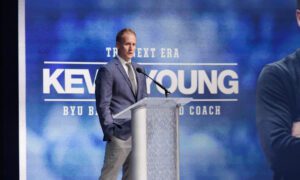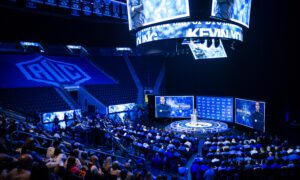
Link to Part 2: Brand/Fan Base Value
Link to Part 2a: Silver vs Altimore Fan Base Estimate
Link to Part 4: TV Market Value
Link to Part 5: Would SDSU & SMU (or Tulane/Rice) Be Dilutive To PAC Media Value?
By Jeff Fuller
PAC10 leaders often tout their strong athletic programs, TV markets, viewership, and academics, but rarely do they try to make a case for having stronger fan bases than other P5 conferences. While there are some programs with solid fan bases (notably Oregon, Washington, and Utah in football, and Arizona in Basketball) it’s pretty clear PAC schools struggle to match the fan engagement level of their peers.
While the most commonly used metrics for evaluating fan passion tend to be attendance figures and TV viewership, social media engagement is quickly becoming an increasingly important factor. While we have addressed TV viewership previously, and plan to address attendance figures in a subsequent installment, this piece will focus on why social media engagement has relevance to media value, and highlights how far behind the PAC finds itself in this arena.
Back in 2019, Stuart Mandel wrote in The Athletic:
“Various metrics show that several top Group of 5 programs could potentially add more value to the conference’s media rights than a few of its current schools do currently.
For example, UCF boasts a larger social media following (a loose proxy for fan engagement) than Baylor, Texas Tech, TCU and Kansas State.”
Is social media really a reliable way to gauge media value? And does online engagement accurately represent the size or passion of a fan base?
Through social media, fans face a low barrier to support their favorite teams. Not all fans can attend games in-person due to a variety of reasons including age, health status, financial constraints, distance, and work or personal-life conflicts. But nearly everyone can pick up a phone and “Like” or “Share” the amazing catch their wide-receiver just made, or the blowout win over their rival school. Similarly, not all contests are on TV, or may just be offered on a streaming service. While fans may not be able to “catch” the game on TV for a variety of reasons, they can still show their support on Facebook, Twitter, or Instagram before, during, or after the whistle blows.
Social media may offer more precise metrics to measure the size and engagement of a school’s fan base than TV viewership
TV viewership is often cited as representative of a program’s media value, but drawing any strong correlation here has limitations and pitfalls. In most viewership evaluations, the average viewers per regular-season game figure (whether it’s per televised game as Sam Bradshaw shared and Krindorr’s V-score data… or Zack Miller’s method of dividing total viewership by the number of games played) is highly dependent on a host of variables:
- Channel and time slot
- Other competing games/programming
- Opponent
- Are either, or both, of the teams involved ranked?
- Lead-in game/programming
- Competitiveness of the game
- Historical storylines, rivalries and what’s “on the line” in said game
While social media interactions may be affected by some of the factors listed above, they’re impervious to most of them. TV broadcasts capture fans of both teams playing (plus some casual college football fans in general), making it difficult to tease out how many of the viewers should be credited as fans towards each team involved. While the networks, or Nielsen, are able to drill down into “per-team metrics” via their internal data, the “normals” like us don’t have access to it. Social media, however, may provide a clearer and cleaner representation of individual teams’ fan bases than raw viewership.
Examples:
- #15 TCU vs #4 Ohio State in 2018 drew a whopping 7.23M viewers, but does TCU really “deserve full credit” for those viewers? TCU games average around 1.5M viewers while OSU averages over 5M viewers. Ohio State is always among the top 3 schools in viewers per game and drew the majority of those eyeballs. TCU also matches up with Texas and Oklahoma yearly, and those games have brought up TCU’s average quite a bit.
- Washington State is often held up as a team with better-than-expected TV scores among the PAC12, but closer analysis of their games shows that the vast majority of these viewers come in games vs Washington, Stanford, Oregon, and USC, all stronger brands than the Cougars.
- Army and Navy end up with better average TV ratings than almost half of all P5 programs, yet they are never suggested for adding media value in conference realignment discussions. This is because the vast majority of their TV numbers are driven by the historic Army vs Navy rivalry game played on CBS that averages 7-8M viewers each year and has no other viewership competition.
Social Media Metrics: PAC10 Struggles
How does the PAC stack up in social media metrics? Using the same idea from The Athletic article above of combining Football, Men’s Basketball, and Main Athletics official accounts, we’ve tabulated both “Total Followers” (TFs) and “Total Interactions” (TIs) as seen below.
The above table shows cumulative data from Facebook, Instagram, Twitter, YouTube, and TikTok from 2019-22 as shared at the Skull Sparks Analytics page (see footnote 1 for details.) While the loss of the USC and UCLA hurts the averages for the PAC12, it pales in comparison to the marked decline in Big12 averages from the exit of Texas and Oklahoma. Despite that, the PAC10 and new Big12 show a nearly identical average number of followers per team at ~1.2M each (adding SDSU/SMU would drop the PAC average slightly to 1.1M.)
When looking at TIs (Total Interactions), however, the PAC lags far behind the Big12, in both current, and future iterations of each. The new Big12 had a 4-year cumulative average TIs per team of 23.0M compared to 15.7M for the PAC10 (a figure that would drop to 13.9M with the additions of SDSU and SMU.) While some of this disparity can be attributed to the PAC’s limited games and relevance during the COVID-shortend 2020 season, the PAC would still be significantly behind the Big12 if the 2020 data was excluded. While we excluded the COVID year from our TV viewership data, and will exclude it from our upcoming piece on attendance, we decided to include it for this social media analysis since it was among the only ways for fans to show support when “socially distant.” While social media engagement did drop through the pandemic, there is evidence of a subsequent strong “pent up demand” for college sports reflected in the data coming out of that time, per Learfield’s report.
The data also shows how dependent the remaining PAC10 are on the Oregon brand/fan base, similar to what our analysis of the TV data showed. The Ducks shine in both TFs (Total Followers) and TIs. Oregon has more social media followers (4.6M) than Washington, Colorado, Washington State, Oregon State, Cal, and Stanford combined. Arizona’s basketball fans show up prominently, elevating the Wildcats to the 2nd spot in TF, at 1.3M, among the remaining PAC10 schools and third in TIs at 17M. Excluding Oregon, the PAC’s per school TIs plummets from 16M to 12M, or about half of the new Big12’s average. “TFs” goes from 1.2M with Oregon, down to 866K without them.
Football Alone Analysis
College football does drive the vast majority of media rights value for any conference, so how do things look when just looking at those football total Interactions? Below are the cumulative TIs for the official Football Team Facebook, Instagram, and Twitter accounts (Kansas State, Cal, and Rice don’t maintain a Football Facebook accounts and USC just started one in 2020. Also, USC has generally focused most of their social media traffic through their Main Athletics accounts for years.) Spreadsheet link and source link from SkullSparks:
Texas and Oklahoma tower over everyone else on this list, generating nearly 100 million interactions between them over the last four years. After that, again Oregon stands out. Nearly all of the new Big12’s teams find themselves on the top half on this list, while the opposite is true for the PAC10. Adding SDSU and SMU to the PAC drags these metrics down even further. Comparing the two, the Big12 averaged 22% more TIs per team from 2019-22 than the PAC. Looking at just 2022, the Big12 had 42% more TIs per team than the PAC. The trajectory differences are striking as well, with the PAC showing very modest 1 and 3 year growth rates of 13% and 18% respectively. Compare that to the Big12’s 1 and 3 year growth rates of 21% and 85%.
Followers vs Interactions: What each metric tells us about a fan base
“Total Followers” provides an glimpse into the size of a fan base, but with some important caveats:
- “TFs” is a cumulative metric, and therefore may not accurately represent currently active fans. If fandom wanes, or allegiances change, not many people digitally trudge back through their “Likes” or “Follows” to remove a team they once claimed, they’d just more likely add a new team. Also, even when people pass on, they continue to continue living as a fan as far as social media goes. People may forget logins and have to create new accounts as well. Additionally, teams that surge into the spotlight to take on a potential “Giant Killer” role (a la Oregon 10-15 years ago, or UCF 6-9 years ago), or potential turnaround story (Dieon Sanders at Colorado), tend to accumulate a lot of casual or “Bandwagon” followers. Some will stay and become fans, but many will jump onto the next hip team.
- Not all followers are fans. This seems especially true within conferences, where many fans follow the major accounts of other conference-mates, either to just keep tabs on them, or to show solidarity within the conference. This can definitely “move the needle” when the largest conferences (soon-to-be 16 team SEC and Big Ten) also have the largest brands and fan bases in the first place. Classic case of “the rich getting richer.” USC changes ???
- Building a large following in the first place requires a balanced mix of competent content teams, recent sports success, and an avid fan base. A program can’t expect to have a huge following if their content team doesn’t have big wins, praising quotes, or high rankings to tout? You could have great teams and a huge fan base, but if there isn’t a good social media content team, but if there’s a tiny fan base to start with, it’s hard to have a huge following. Much of social media success is based on having a dedicated team to provide relevant, exciting, and high-quality digital content.
- Some question the validity of social media metrics over concerns of “astroturfing” with “bought followers,” aggressive marketing campaigns, “burner” or “bot” accounts, and “click farms.” However, we’re not aware of these activities happening on a large scale within college sports.
“Total Interactions” reflects the current engagement/passion of a fan base more than total followers.
- Per SkullSparks, interactions were defined as:
- Instagram: “Like” or Comment
- Facebook: Reaction, comment, or Share
- Twitter: Comment, “Like,” or Retweet
- TikTok: “Likes” (cumulative for accounts)
- If TFs are the size/stature of a program, TIs are the vitality/pulse.
- “Interactions per follower” serves to highlight fan base engagement and current brand relevance. A high number in this metric may indicate recent high-level success, a surging fan base, or just one that is generally more engaged/passionate than average.
- While interactions peak on game days, social media allows fans to engage and show support throughout the week. Again, per Learfield’s report.
Conclusion
Our previous reports have shown relative trajectory concerns for the PAC in areas such as TV viewership, TV markets, and overall brands. While the PAC does still have some strengths, social media engagement has proven to be a relative weakness. This speaks to a lack of fan passion and engagement conference-wide and confirms the suspicions of many that several once strong PAC10 brands and fan bases are in relative, if not absolute, decline.
——————————————————————————————————————————————————-
This linked Spreadsheet, details all the cumulative figures from SkullSparks graphics for Facebook, Twitter, and Instagram for:
- Main Athletics account Followers (plus TikTok Likes & YouTube Subscribers)
- Football Followers (plus TikTok likes)
- Football Interactions (plus NFL draft interactions for 2020, 2021, & 2022)
- Basketball Followers
- Basketball Interactions
SkullSparks had been including team mascot accounts as Main athletics accounts for TIkTok until a few months ago if a school chose to use that as their main TikTok account (here’s their report from a year ago, with mascot accounts, and with them excluded now.) BYU’s Cosmo, Oregon’s “The Duck,” and OSU’s “Brutus,” have massive TikTok followings. While it’s clear that most TikTok-ers who likes a video of Brutus or The Duck doing something humorous, or follow Cosmo for his amazing stunts and dancing prowess are not actually fans of the teams, it also didn’t seem quite right to give a “zero” to those programs since the schools had been directing significant social media efforts towards them and there are plenty of fans that follow/interact with those accounts. I just arbitrarily decided to give a 15% value for Followers and Likes for Cosmo, Duck, Brutus, Minnesota’s “Gophie.”














